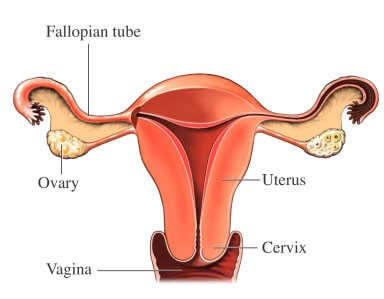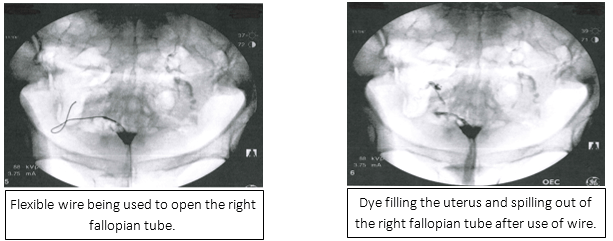Evaluation
As part of evaluating a couple’s fertility concerns it is often necessary to determine if the fallopian tubes are open; that is, can sperm travel through the uterus and to the distal most end of the fallopian tubes to reach the egg for fertilization at the time of ovulation. Additionally, it may be necessary to determine if there are abnormalities in the shape or structure of the uterus. This is traditionally determined by a procedure known as a hysterosalpingogram or “HSG.”

An HSG is typically performed by a radiologist in a hospital setting and without anesthesia. A device is placed on the cervix and dye is injected into the uterus
under pressure. This causes the dye to fill the cavity of the uterus and then, ideally, flow into and through the fallopian tubes, spilling out the end of the tubes into the pelvis. The dye can be seen on x-ray, which is used to monitor the procedure.
It is common for an HSG to reveal what appears to be blocked tubes. However, there may only be tubal spasm occurring and not actual blockage, and/or there is a reversible blockage. The traditional HSG is a commonly performed test, but it often offers incomplete information.
Alternatives
We perform an alternative to the traditional HSG, a “selective HSG.” A selective HSG differs from a traditional HSG in that we “select” each tube individually and inject dye while monitoring the pressure required for the dye to spill through the tube into the pelvis. If there is flow through the tube, but at high pressure, or the tube appears blocked, we can then thread a tiny flexible wire into the fallopian tube. By doing this we can often dislodge debris or mucus plugs, opening a previously blocked or partially blocked tube. This procedure alone has been shown to greatly improve fertility rates in the cycles that follow it.

It is necessary to use anesthesia for this procedure due to anticipated discomfort when injecting the dye and threading the wire through the fallopian tubes. There are minimal risks, if any, to the procedure, which generally takes only a few minutes to perform. In most cases we perform a selective HSG at the same time we perform diagnostic laparoscopy, although it is possible to perform it as a stand-alone procedure.
